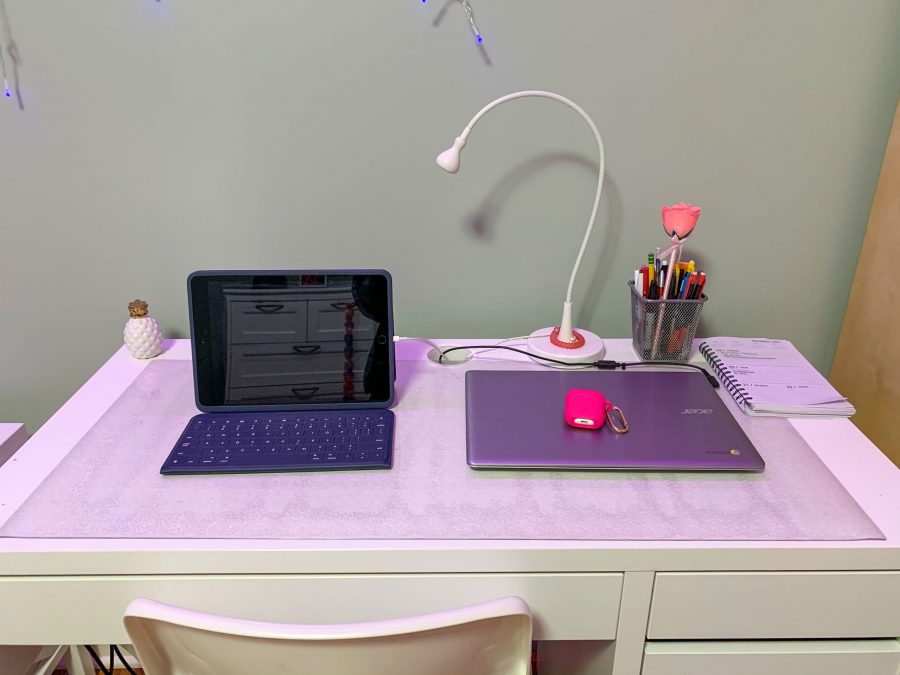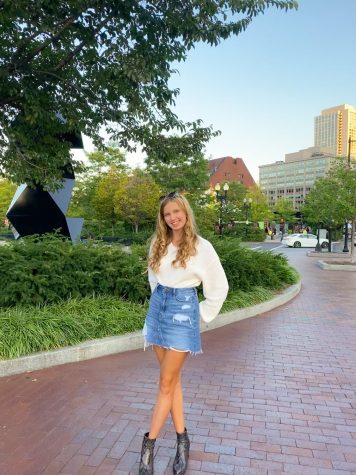“You can’t get lost on a google meet”: the start of high school in a global pandemic
December 16, 2020
Four years ago, a shorter, sass-less, scared freshman Alexa Vierschilling gripped her highlighted map during the car ride to her first day of high school.
She doesn’t remember what she was wearing, but she assumes her innocent past-self would have worn a striped dress, probably accompanied by a pair of converse sneakers. She doesn’t remember what happened when she first walked through door number one. But she remembers one thing like it was yesterday: the way her hands shook the frail paper, chalked with arrows that she believed would tell her where to go.
“I really thought I was gonna throw up in the car on the way there,” Vierschilling said. “I was thinking, ‘this is gonna be terrible.’ You know, you’re so excited because after eighth grade, you’re like ‘wow, I’m going to high school…’ but then, the day comes, and you’re nowhere near ready for it.”
Vierschilling arrived at the high school early, and she asked teachers for directions so that she could reach her first-period class with time to spare. But, even with her nose in her map, Vierschilling got hopelessly lost on the way to second period English with Mr. Capron.
“The best part about that was that somebody else came in after me, so I didn’t even feel like I was like, the most confused person, which is great,” Vierschilling said.
After that small hiccup, Vierschilling’s routes were less convoluted, and her sense of hallway direction seemingly improved. She admits that the worst part of her day was the car ride back home when she had to admit that her mother was right. High school just isn’t that bad.
Freshman Hannah Solomon would beg to differ.
In July 2020, she started to stock up on new jeans that she wanted to wear on her first day.
“I wanted new [jeans] to start high school with,” Solomon said. “I had some already, but I wanted a new pair [for the first day].”
In August 2020, Solomon realized that she wouldn’t be wearing those jeans in front of the strangers from the other side of town for at least three months.
“I was excited [to] get back to normalcy,” Solomon said. “The whole summer, I was in quarantine, basically, so I was excited to know that we’d kind of be getting back to normal, but that’s not the case now.”
At her in-person freshman orientation, Solomon was worried she’d get lost in the abyss as a senior guided her through the halls.
“I was a little bit nervous because every hallway looks the same, so I [was] kind of nervous that I [was] going to be late to my classes because I [got] lost and stuff even though there’s signs around saying the room numbers,” Solomon said. “I was just nervous and unsure about where I was.”
On the day of her orientation, Solomon was less nervous than she expected to be. If anything, she was eager to get into the building–a distinct contrast to the feelings Vierschilling experienced leading up to the start of high school.
“I feel like everyone’s going to be in the same boat as me,” Solomon said. “So, if something happens to me, the teachers and everyone will probably be understanding of that….”
High school map? Printed. Outfit? Planned. Back-up masks? Inside her backpack. Leading up to her first in-person day on Nov. 19, Solomon had accepted that she could only control so much, and she was ready to face the peculiarly-marked hallways and the people whose icons she had seen on Google Meet.
She was “shocked and disappointed,” when she got wind that she would not be leaving her desk until at least January. Solomon noted that she was frustrated by the abruptness of the decision; she felt blindsided by the lack of notice.
On Nov. 19, Solomon rolled out of bed at the same time she has every day since September. She brushed her teeth before she ate her waffle and sat in bed on her phone for a few minutes before she made the only 6-foot travel she would take that day: the colossal commute from her bed to her desk. She opened her school-issued iPad so that she could open her Google Meet at 8:30 a.m., and opened up her computer next to her in case she needed it for any assignments. She kept her clear tumbler of water beside her and a few snacks in case she got hungry.
“I was disappointed,” Solomon said. “I was upset about [the decision to stay virtual] because I was really excited to have that chance [to meet my teachers and new classmates].”
Solomon thought that her older friends were exaggerating the increase in workload from middle school to high school, but she quickly realized that not having to study for tests was a thing of the past. What her older friends couldn’t have warned her about was how quickly burnout can come calling when that workload is entirely solitary.
“There’s nothing to really [to] pump me up–in school, I would see my friends and we would talk so [without that]… I just don’t have any energy…,” Solomon said. “I’m basically just sitting in my room by myself every single day. [It’s] hard.”
It remains unknown how long it will be until Solomon can pull her new high school jeans out of her drawer. But until then, she remains hopeful that she will start her in-person high school experience sooner rather than later.
“We hope our 9th-grade students and all of our students know we are here if they need anything,” guidance counselor Suzanne Wojcik said. “We want to support our students academically and emotionally and hope they know that. We miss the students in the building and can’t wait to welcome everyone back in some form.”



